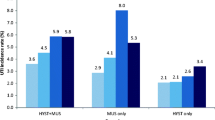Abstract
The objective of this study is to assess the impact of bladder catheterization on the incidence of postoperative urinary tract infection (UTI) and urinary retention (PUR) following laparoscopic-assisted vaginal hysterectomy (LAVH). One hundred fifty patients undergoing LAVH were randomly assigned to no catheter use, 1-day, and 2-day catheter groups. The relationship between preoperative, intraoperative, and postoperative factors and the rates of UTI and PUR were determined. The incidences of UTI and PUR were 9.3% and 18.7%, respectively. The highest rate of UTI occurred in the 2-day catheter group; the highest rate of PUR occurred in no-catheter-use group. Multivariable logistical regression showed the duration of catheterization was the single predictor of UTI; duration of catheterization and diabetes mellitus were predictors for PUR. While short-term indwelling catheterization resulted in decreased rate of PUR, UTI rate increased among patients undergoing LAVH. Nonetheless, most patients resumed normal urination shortly after surgery.


Similar content being viewed by others
References
Pokras R, Hufnagel VG (1987) Hysterectomies in the United States. Vital Health Stat 92:1–32
Hinman F (1976) Postoperative over-distension of the bladder. Surg Gynecol Obstet 142:901–902
Givens CD, Wenzel RP (1980) Catheter associated urinary tract infection in surgical patients: a controlled study on the excess morbidity and costs. J Urol 124:646–648
Kingdom JCP, Kitchener HC, MacClean AB (1990) Postoperative urinary tract infection in gynecology: implications for an antibiotic prophylaxis policy. Obstet Gynecol 76:636–638
Wang CJ, Yen CF, Lee CL, Tashi T, Soong YK (2004) Laparoscopically assisted vaginal hysterectomy for large uterus: a comparative study. Eur J Obstet Gynecol Reprod Biol 115:219–223
Olive DL, Parker WH, Cooper JM, Levine RL (2000) The AAGL classification system for laparoscopic hysterectomy. Classification committee of the American Association of Gynecologic Laparoscopists. J Am Assoc Gynecol Laparosc 7:9–15
Ware JE, Sherbourne CD (1992) The MOS 36-Item short-form health survey. Conceptual framework and item selection. Med Care 30:473–483
Uebersax JS, Wyman JF, Shumaker SA, McClish DK, Fantl JA (1995) Short forms to assess life quality and symptom distress for urinary incontinence in women: the Incontinence Impact Questionnaire and the Urogenital Distress Inventory. Continence Program for Women Research Group. Neurol Urodyn 14:131–139
Hung MJ, Liu FS, Shen PS, Chen GD, Lin LY, Ho ESC (2004) Analysis of two sling procedures using polypropylene mesh for treatment of stress urinary incontinence. Int J Gynecol Obstet 84:133–141
Schaeffner AJ, Chmiel J (1983) Urethral meatal colonization in the pathogenesis of catheter-associated bacteria. J Urol 130:1096–1099
Tammela T (1995) Postoperative urinary retention—why the patient cannot void. Scand J Urol Nephrol 175(Suppl):75–77
Tammela T, Kontturi M, Lukkarinen O (1986) Postoperative urinary retention. Incidence and predisposing factors. Scand J Urol Nephrol 20:197–201
Stanton SL, Cardozo LD, Kerr-Wilson R (1979) Treatment of delayed onset of spontaneous voiding after surgery for incontinence. Urology 13:494–496
Bodker B, Lose G (2003) Postoperative urinary retention in gynecologic patients. Int Urogynecol J 14:94–97
Ghezzi F, Cromi A, Uccella S, Colombo G, Salvatore S, Tomera S et al (2007) Immediate Foley removal after laparoscopic and vaginal hysterectomy: determinants of postoperative urinary retention. J Minim Invas Gynecol 14:706–711
Evron S, Samueloff A, Simon A, Drenger B, Magora F (1985) Urinary function during epidural analgesia with methadone and morphine in post-cesarean section patients. Pain 23:135–144
Bartzen PJ, Hafferty FW (1987) Pelvic laparotomy without an indwelling catheter. A retrospective review of 949 cases. Am J Obstet Gynecol 156:1426–1432
Summitt RL, Stovall TG, Bran DF (1994) Prospective comparison of indwelling bladder catheter drainage versus no catheter after vaginal hysterectomy. Am J Obstet Gynecol 170:1815–1818
Dobbs SP, Jackson SR, Wilson AM, Maplethorpe RP, Hammond RH (1997) A prospective, randomized trial comparing continuous bladder drainage with catheterization at abdominal hysterectomy. Br J Urol 80:554–556
Shiotz HA (1994) Urinary tract infections and bacteriuria after gynecological surgery. Experience with 24-hour Foley catheterization. Int Urogynecol J 5:345–348
Petros JG, Alaeddine F, Testa E, Rimm EB, Robillard RJ (1994) Patient controlled analgesia and post operative urinary retention after hysterectomy for benign disease. J Am Coll Surg 179:663–667
Hakvoort RA, Elberink R, Vollebregt A, Van der Ploeg T, Emanuel MH (2004) How long should urinary bladder catheterization be continued after vaginal prolapse surgery? A randomized controlled trial comparing short term versus long term catheterization after vaginal prolapse surgery. BJOG 111:828–830
Richardson AC, Lyon JB, Graham EE (1973) Abdominal hysterectomy: relationship between morbidity and surgical technique. Am J Obstet Gynecol 115:953–961
Ireland D, Tacchi D, Bint AJ (1982) Effect of single-dose prophylactic co-trimoxazole on the incidence of gynecological postoperative urinary tract infection. Br J Obstet Gynecol 89:578–580
Acknowledgement
This work was supported by Medical Research Project Grant CMRPG 360291 and BMRP 412 from Chang Gung Memorial Hospital. We would like to thank the following gynecologists for their assistance to accomplish this study: SD Chang, HY Huang, KJ Huang, CW Wang, LH Tseng, and CM Han.
Conflicts of interest
None.
Author information
Authors and Affiliations
Corresponding author
Rights and permissions
About this article
Cite this article
Liang, CC., Lee, CL., Chang, TC. et al. Postoperative urinary outcomes in catheterized and non-catheterized patients undergoing laparoscopic-assisted vaginal hysterectomy—a randomized controlled trial. Int Urogynecol J 20, 295–300 (2009). https://doi.org/10.1007/s00192-008-0769-6
Received:
Accepted:
Published:
Issue Date:
DOI: https://doi.org/10.1007/s00192-008-0769-6




